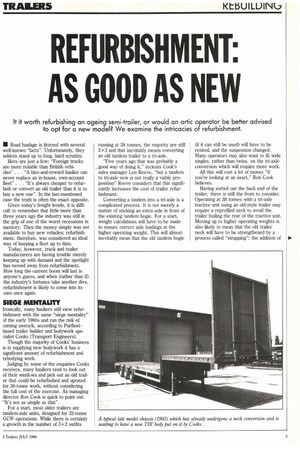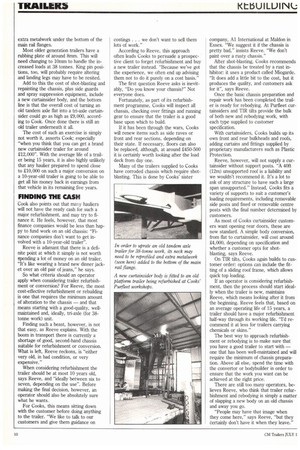REFURBISHMENT: AS GOOD AS NEW
Page 47

Page 48

If you've noticed an error in this article please click here to report it so we can fix it.
• Road haulage is littered with several well-known "facts". Unfortunately, they seldom stand up to long, hard scrutiny.
Here are just a few: "Foreign trucks are more reliable than British vehicles". . . "A hire-and-reward haulier can never replace an in-house, own-account fleet" . . . "It's always cheaper to refurbish or convert an old trailer than it is to buy a new one". In the last-mentioned case the truth is often the exact opposite.
Given today's freight levels, it is difficult to remember that little more than three years ago the industry was still in the grip of one of the worst recessions in memory. Then the money simply was not available to buy new vehicles; refurbishment, therefore, was considered an ideal way of keeping a fleet up to date.
Today, however, truck and trailer manufacturers are having trouble merely keeping up with demand and the spotlight has moved away from refurbishment How long the current boom will last is anyone's guess, and when (rather than if) the industry's fortunes take another dive, refurbishment is likely to come into its own once again.
SIEGE MENTALITY
Ironically, many hauliers still view refurbishment with the same "siege mentality" of the early 1980s and run the risk of coming unstuck, according to Purfleetbased trailer builder and bodywork specialist Cooks (Transport Engineers).
Though the majority of Cooks' business is in supplying new bodywork it has a significant amount of refurbishment and rebodying work.
Judging by some of the enquiries Cooks receives, many hauliers tend to look out of their windows and pick out an old trailer that could be refurbished and uprated for 38-tonne work, without considering the full cost of the exercise. As managing director Ron Cook is quick to point out: "It's not as simple as that".
For a start, most older trailers are tandem-axle units, designed for 32-tonne GCW operations. While there is certainly a growth in the number of 3+2 outfits
running at 38 tonnes, the majority are still 2+3 and that inevitably means converting an old tandem trailer to a tri-axle.
"Five years ago that was probably a good way of doing it," reckons Cook's sales manager Len Reeve, "but a tandem to tri-axle now is not really a viable proposition" Reeve considers that this significantly increases the cost of trailer refurbishment.
Converting a tandem into a tri-axle is a complicated process. It is not merely a matter of sticking an extra axle in front of the existing tandem bogie. For a start, weight calculations will have to be made to ensure correct axle loadings at the higher operating weight. This will almost inevitably mean that the old tandem bogie (if it can still be used) will have to be resited, and the suspension changed. Many operators may also want to fit wide singles, rather than twins, on the tri-axle conversion which will require more work.
All this will cost a lot of money "if you're looking at an asset," Ron Cook believes.
Having sorted out the back end of the trailer, there is still the front to consider. Operating at 38 tonnes with a tri-axle tractive unit using an old-style trailer may require a reprofiled neck to avoid the trailer fouling the rear of the tractive unit_ Moving up to higher operating weights is also likely to mean that the old trailer neck will have to be strengthened by a process called "strapping": the addition of extra metalwork under the bottom of the main rail flanges.
Most older generation trailers have a rubbing plate of around 8mm. This will need changing to 10mm to handle the increased loads at 38 tonnes. King pin positions, too, will probably require altering and landing legs may have to be resited.
Add to this the cost of shot-blasting and repainting the chassis, plus side guards and spray suppression equipment, include a new curtainsider body, and the bottom line is that the overall cost of turning an old tandem axle flat into a tri-axle curtainsider could go as high as 29,000, according to Cook. Once done there is still an old trailer underneath it all.
The cost of such an exercise is simply not worth it, asserts Cook; especially "when you think that you can get a brand new curtainsider trailer for around £12,000". With the average life of a trailer being 15 years, it is also highly unlikely that any haulier prepared to spend close to £10,000 on such a major conversion on a 10-year-old trailer is going to be able to get all his money back in earnings from that vehicle in its remaining five years.
FINDING THE CASH
Cook also points out that many hauliers will not have the ready cash for such a major refurbishment, and may try to finance it. He feels, however, that most finance companies would be less than happy to fund work on an old chassis: "Finance companies don't want to get involved with a 10-year-old trailer".
Reeve is adamant that there is a definite point at which it simply is not worth spending a lot of money on an old trailer. "It's like wearing a brand new dinner jacket over an old pair of jeans," he says.
So what criteria should an operator apply when considering trailer refurbishment or conversion? For Reeve, the most cost-effective refurbishment or rebuilding is one that requires the minimum amount of alteration to the chassis — and that means starting with a good-quality, wellmaintained and, ideally, tri-axle (for 38tonne work) unit.
Finding such a beast, however, is not that easy, as Reeve explains. With the boom in transport there is currently a shortage of good, second-hand chassis suitable for refurbishment or conversion. What is left, Reeve reckons, is "either very old, in bad condition, or very expensive."
When considering refurbishment the trailer should be at most 10 years old, says Reeve, and "ideally between six to seven, depending on the use". Before making the final decision, however, an operator should also he absolutely sure what he wants.
For Cooks, this means sitting down with the customer before doing anything to the trailer. "We like to talk to our customers and give them guidance on castings . . we don't want to sell them lots of work."
According to Reeve, this approach often leads Cooks to persuade a prospective client to forget refurbishment and buy a new trailer instead. "Because we've got the experience, we often end up advising them not to do it purely on a cost basis."
The first question Reeve asks is inevitably, "Do you know your chassis?" Not everyone does.
Fortunately, as part of its refurbishment programme, Cooks will inspect all chassis, checking over fittings and running gear to ensure that the trailer is a good base upon which to build.
If it has been through the wars, Cooks will renew items such as side raves or front and rear sections, depending on their state. If necessary, floors can also be replaced, although, at around 2450-500 it is certainly worth looking after the load deck from day one.
Many of the trailers supplied to Cooks have corroded chassis which require shotblasting. This is done by Cooks' sister company, Al International at Maldon in Essex. "We suggest it if the chassis is pretty bad," insists Reeve. "We don't paint over a rusty chassis."
After shot-blasting, Cooks recommends that the chassis be treated by a rust inhibitor: it uses a product called Miogarde. "It does add a little bit to the cost, but it produces the quality, and customers ask for it", says Reeve.
Once the basic chassis preparation and repair work has been completed the trailer is ready for rebodying. At Purfleet curtainsiders and TIR tilts provide the bulk of both new and rebodying work, with each type supplied to customer specification.
With curtainsiders, Cooks builds up its own front and rear bulkheads and roofs, adding curtains and fittings supplied by proprietary manufacturers such as Plastic Protection.
Reeve, however, will not supply a curtainsider without support posts. "A 40ft (12m) unsupported roof is a liability and we wouldn't recommend it. It's a lot to ask of any structure to have such a large span unsupported." Instead, Cooks fits a variety of supports to suit a customer's loading requirements, including removable side posts and fixed or removable centre posts with the final number determined by customers.
As most of Cooks curtainsider customers want opening rear doors, these are now standard. A simple body conversion, from flat to curtainsider, will cost around £4,000, depending on specification and whether a customer opts for shotblasting, says Reeve.
On TIR tilts, Cooks again builds to customer order: options can include the fitting of a sliding roof frame, which allows quick top loading.
If an operator is considering refurbishment, then the process should start ideally when the trailer is new, maintains Reeve, which means looking after it from the beginning. Reeve feels that, based on an average operating life of 15 years, a trailer should have a major refurbishment half-way through its working life. "I'd recommend it at less for trailers carrying chemicals or skins."
The best way to approach refurbishment or rebodying is to make sure that you have a good trailer to start with — one that has been well-maintained and will require the minimum of chassis preparation. Above all else, spend the time with the convertor or bodybuilder in order to ensure that the work you want can be achieved at the right price.
There are still too many operators, believes Reeve, who think that trailer refurbishment and rebodying is simply a matter of slapping a new body on an old chassis and away you go.
"People may have that image when they come here," says Reeve, "but they ertainly don't have it when they leave."




























































